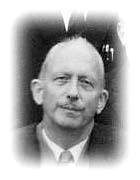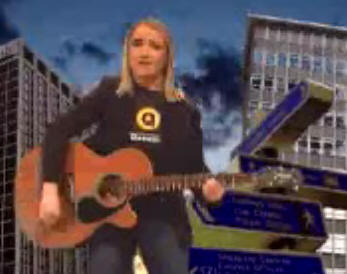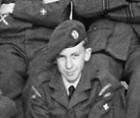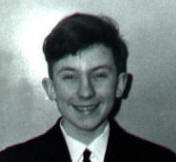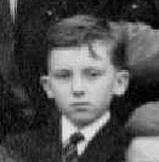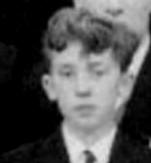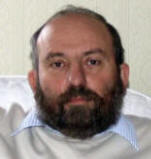|
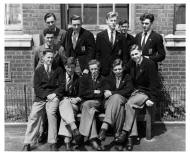 I
have at last found a half-decent photo [shown
left] taken by RJ Hawkins of some of the Upper VIth at Tamworth Road
in the summer of 1950. It is taken from the Tamworth Road side and it is
possible to see how much attention some of the window frames needed – I
don’t think they had been painted since before the war. The windows are
those of the Library, which was created in 1946, a long room which had
been formerly the woodwork shop, ruled over by Mr. Chinnock. When he
left all the benches and tools disappeared, and what was the last
vestige of the old "Selective Central School" (what Mr. MacLeod had
called "The Grammar School on the cheap") finally disappeared. I
have at last found a half-decent photo [shown
left] taken by RJ Hawkins of some of the Upper VIth at Tamworth Road
in the summer of 1950. It is taken from the Tamworth Road side and it is
possible to see how much attention some of the window frames needed – I
don’t think they had been painted since before the war. The windows are
those of the Library, which was created in 1946, a long room which had
been formerly the woodwork shop, ruled over by Mr. Chinnock. When he
left all the benches and tools disappeared, and what was the last
vestige of the old "Selective Central School" (what Mr. MacLeod had
called "The Grammar School on the cheap") finally disappeared.
Mr. Chinnock always seemed a sad person; I think he had lost a son
in the war. He used to be in charge of National Savings. Every Monday
morning every boy had to buy at least one National Savings stamp, price
6d – or 5 pence in modern money. I remember one lad in our form whose
parents, I think, were both on war work who used to by £1’s
worth every week – a vast sum in those days! Mr. Chinnock was a fine
craftsman but not many of us could approach his skills, so the work must
have been a bit dispiriting. After 1944 I suspect he felt less at home
in the atmosphere of the new Grammar School with its new driving
academic ethos.
The names of the people in the photo (from left to right) are as
follows:
Back row standing: Derek Howes, John Prevett,
Vic Carter, Philip "Flapper" Bamford and
Karl Smith.
Front row standing: Terence Morris.
Seated: Andrew McIntyre, Peter Heath, Tony Nye,
Percy Prevett and Owen Everson.
I have kept touch only with Tony Nye but he is in touch with Peter
Heath, The Prevett Brothers and Owen Everson.
● Derek Howes became a schoolmaster in London. He was a talented actor and
pianist. He and I, sometimes joined by Terry Constable (not in photo)
used to gather round our piano at home and sing the advertisements in
the New Statesman to Anglican chants. (Innocent, if somewhat irreligious,
amusement.)
● John Prevett became an actuary and was subsequently rewarded
with an OBE for his pro bono work for the victims of the
thalidomide tragedy.
● Vic Carter, after taking a science degree, became an army officer and went
on to the staff of the Military College at Shrivenham.
I have no knowledge of the later career of Philip "Flapper" Bamford, nor
indeed, of how he acquired that name!
● Karl Smith after university went to the Royal Aircraft Establishment at
Farnborough where, at the 1952 air show, he and I had witnessed the
tragic disaster when the new DH 110 broke up in mid-air.
● Terence Morris (that’s me) became a member of the staff of the London
School of Economics, eventually settling to be a criminologist.
I have no knowledge of Andrew McIntyre’s later career.
● Peter Heath, whose copy of Carlyle’s French Revolution is still in my
possession – gift or long-term loan, after 56 years I can’t remember -
joined the staff of the History Department at the University of Hull.
(Peter, if you should read this and want it back, just send me your
address...)
● Tony Nye read English at UCL. His children’s book,
The Witch’s Cat, was
published while he was in the Sixth. He and I edited the School Magazine
for a while. He became a Jesuit priest and has had a long and
distinguished career in various parts of the world, having been
headmaster of a Jesuit school, a missionary in South Africa during
apartheid and parish priest of Farm Street in London’s West End. [Father
Nye was also guest of honor at the 1971 Speech Day, the school's 50th
Anniversary year
 - ML.]
- ML.]
● Percy Prevett became an entomologist and, I think, worked in West Africa.
● Owen Everson was ordained as an Anglican priest and became a Canon of
Southwark Cathedral. He retired from London to Chichester.
Neither Tony Nye nor I have any information about R. J. Hawkins, who took
the photo. Other people, not pictured, but in the VIth at that time
included Terence Constable, who read French at King’s College London and,
was at one time, a teacher in Wormwood Scrubs prison, and Bruce Vail, who
read Classics at King’s.
I think there were times when Mr. Lowe found us quite a handful; a
relatively small group of very eager teen-agers on the threshold of
adulthood. Seriously religious in a number of cases and very political.
But I think, on the whole, he was not displeased to learn of what we
were doing afterwards.
The majority of people in the photo came down
from University with Firsts and Upper Seconds in both science and arts
degrees. Everyone in that photo will now be in their early- to mid-Seventies.
Is any of our generation "on-line," I wonder, apart from myself and
Dudley Wolf?
Prefects' Badges
Regarding the circular badges that some
people in the photo are wearing on the lapels of their blazers, these
were
 metal
and of the same design as that published on the front page of the School
Magazine, shown
left, and designated that they were Prefects. The shield-shaped badges
on the blazer pockets were the school blazer badge. The circular design
was never a blazer badge, but was widely used on sticky labels put
inside books and on the covers of exercise books. I still have most of
my Sixth Form exercise books and they all have the circular design on
the label. My guess is that it was the original school badge, dating
from 1920 when the School first opened in Scarbrook Road, next to what
used to be the Croydon Baths. That building, like the one in Tamworth
Road, was also "second hand", so to speak, as it had previously housed
the Girls’ Department of what was called the British School. metal
and of the same design as that published on the front page of the School
Magazine, shown
left, and designated that they were Prefects. The shield-shaped badges
on the blazer pockets were the school blazer badge. The circular design
was never a blazer badge, but was widely used on sticky labels put
inside books and on the covers of exercise books. I still have most of
my Sixth Form exercise books and they all have the circular design on
the label. My guess is that it was the original school badge, dating
from 1920 when the School first opened in Scarbrook Road, next to what
used to be the Croydon Baths. That building, like the one in Tamworth
Road, was also "second hand", so to speak, as it had previously housed
the Girls’ Department of what was called the British School.
Both blazer badge and label design were around and in use when I
entered the school in 1942. Blazers and ties could only be bought at
Hewitt’s Outfitters in Church Street and were made of black Vicuna
cloth. Boys in the two entry forms were known as "Brats" and wore short
trousers for two years before going into longs. The were also from
Hewitt's but a lot of parents bought shirts at M&S at West Croydon whose
quality was very good – probably better – and cheaper.
As to sports jackets, they are worn by Derek Howes and myself. It
was a sort of informal fashion that some of us started when we going off
for interviews, etc., or in my case teaching elsewhere. In my case there
was no-one to teach economics for Higher School Certificate – the
forerunner of A level - so I had to journey up to the City of London
College, now part of London Metropolitan University, to lectures there
on their Intermediate BSc Econ. Course. This informal dress was not
popular with John Lowe, but it was one of the many things he had to put
up with from us!
If the picture was in colour, it would be possible to see that
there were four patterns of tie with a predominate stripe corresponding
to the House one was in: red for Alpha, blue for Beta, gold for Gamma
and green for Delta. Age quod agis, the motto under the badge,
was translated by Mr. MacLeod as “Do what you do”. “Attend to what you
are about” might be an alternative.
Early in the period of John Lowe’s time as Head, Mr. Manning, who
went on to become Head of the new Ashburton Comprehensive – known as the
Cashburton on account of having allegedly been over budget in the
building – produced the School Song with its rousing chorus To be
worthy of our name. It appeared around the time of a book about
Ruskin which dealt with the fact that Ruskin’s wife Effie had gone off
with the painter Millais, suggesting that Ruskin was not up to much in
the bedroom. Cannot recall either book or author, I’m afraid. But John
Lowe was outraged and in assembly indicated that we should not believe
any of these slanders on Ruskin.
I recall only one verse of
the song:
To his memory by a mountain lake
A pillar stands alone
And the words of timeless wisdom
Graven on the ancient stone
Show a faith in God’s abiding love
Which we must make our own
To be worthy of our name.
The tune was written by Mr.
Hancock and was a good sing along, as I recall. Opinions varied as to the
literary merit of Mr. Manning’s work. [more]
I do recall a remark that if Effie had stayed married to Ruskin he
would have ended up writing Bubbles. Millais’ painting Bubbles,
you will recall, was subsequently used as an advertisement for Pears
Soap.
Terence Morris, Hampshire,
September 2005 Email
Mike Marsh
(JRGS 1949-55) adds:
Thanks to Terence Morris for the details and photos of the 1950
prefects. These were those "in power" when I first arrived at Tamworth
Road in September 1949, and many of the names I can remember, with his
prompting. As "Brats" that year, I can well remember being in awe of
these chaps who, on the first morning, were standing on top of the steps
glowering at us and looking very important as we assembled in the
playground. They were able to dish out "lines" and similar punishments
for misdemeanours - how far they could go I do not know!
 I am a little confused though by his comments about the Library, the
Woodwork Room and Mr. Chinnock, pictured left. As far as I remember,
the library was on the right-hand end of the Woodwork Room looking from
the playground. Also looking at the school's architects' drawings (on
this web site but
not very clear - I have a clearer copy that I can enlarge). The woodwork
room occupied two thirds of the ground floor front between the two
doors, with the library being the other one third, which is exactly how
I recollect it. These drawings show the ground floor plan and were drawn
up for the new science labs out at the back of the school, so must be
dated about 1946 or 47, since the new labs opened in September 1948. The
layout of the woodwork room and library are clearly shown.
I am a little confused though by his comments about the Library, the
Woodwork Room and Mr. Chinnock, pictured left. As far as I remember,
the library was on the right-hand end of the Woodwork Room looking from
the playground. Also looking at the school's architects' drawings (on
this web site but
not very clear - I have a clearer copy that I can enlarge). The woodwork
room occupied two thirds of the ground floor front between the two
doors, with the library being the other one third, which is exactly how
I recollect it. These drawings show the ground floor plan and were drawn
up for the new science labs out at the back of the school, so must be
dated about 1946 or 47, since the new labs opened in September 1948. The
layout of the woodwork room and library are clearly shown.
The woodwork room remained in use until the school closed in 1955
and was one of my favourite haunts as woodwork was one of my "better"
subjects. Before Mr. Chinnock died in February 1955 he was off work ill
for quite some time - 14 months in fact - and we had one or two supply
teachers to keep us going during that period. But I do not think he left
as such, but died in office, although not actually being at work at the
time. Possibly he was officially retired in December 1954; I do not
know. (I remember being off work long-term sick myself as a teacher and
I was on-role and paid for 12 months, albeit at half pay for the second
half year, and retiring at the end of that time.)
The John Ruskin School Magazine for
July 1954 laments
Mr. Chinnock's passing, and states on
page 4 that he had
been off work since December 3rd [sic 1953], and the Supply
Teachers were Mr. Lewis and Mr. Crampton. Certainly the workshop,
benches and tools remained in situ and in use by us until we moved out
in 1955, at that time with Mr. Crampton in charge. (Who remembers his
old motorbike and sidecar held together with wire and string? I do!) I
was to meet him again in London a few years later, and subsequently I
went to work for his father in a Quantity Surveyors' office in London
until I went into the RAF in February 1957. I don't think that Mr.
Crampton moved to Shirley Road with us, as very little happened in the
new woodwork room that summer term, although I was involved with someone
helping to establish the new benches, cupboards and tool racks in there.
Whether this was with the new appointee - or indeed whether it was Mr.
Crampton - I do not recollect, but I believe that woodwork lessons were
not held that last (for me) term.
|



 I am a little confused though by his comments about the Library, the
Woodwork Room and Mr. Chinnock, pictured left. As far as I remember,
the library was on the right-hand end of the Woodwork Room looking from
the playground. Also looking at the school's architects' drawings (on
this
I am a little confused though by his comments about the Library, the
Woodwork Room and Mr. Chinnock, pictured left. As far as I remember,
the library was on the right-hand end of the Woodwork Room looking from
the playground. Also looking at the school's architects' drawings (on
this 